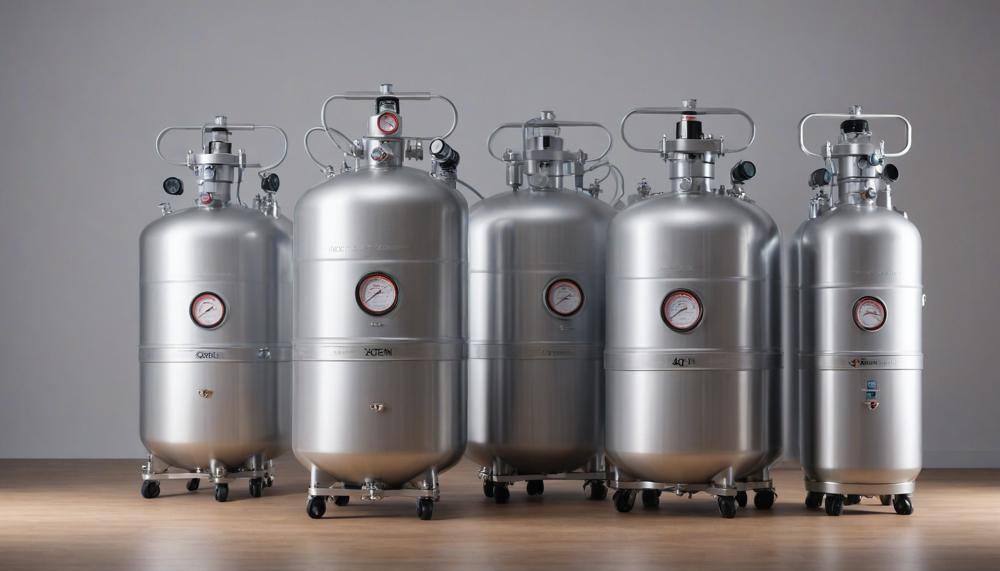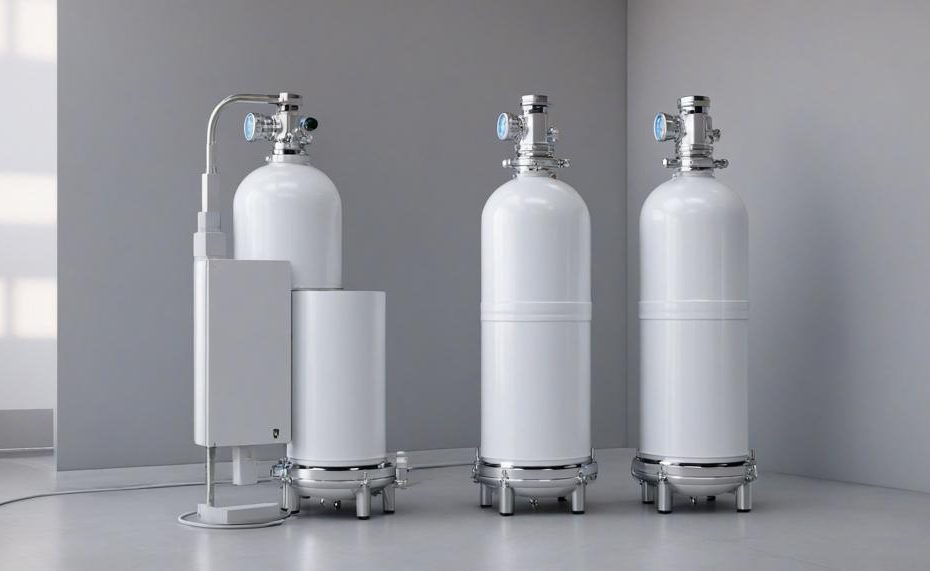Disposing of oxygen tanks might seem tricky, but with the right steps, it’s straightforward and safe. Here’s a quick rundown to guide you:
- Contact local authorities: Start by reaching out to your local waste management company or hazardous waste disposal facility. They’ll tell you if they accept oxygen tanks for recycling.
- Remove attachments: Take off any accessories or attachments from the tank before you start the disposal process.
- Release remaining gas: Ensure the tank is completely empty by releasing any leftover gas in a well-ventilated area.
- Proper containment: Place the empty tank in a container or bag specifically designed for medical waste, and make sure to label it as an oxygen tank.
- Follow disposal instructions: Adhere to the guidelines provided by the waste management or hazardous waste disposal facility for safe recycling.
Getting rid of oxygen tanks correctly is crucial for both safety and environmental protection. By following these steps, you’ll not only keep yourself and others safe but also contribute to a healthier planet.
Contents
Proper Disposal of Oxygen Tanks: Why It Matters
Disposing of oxygen tanks properly is crucial for several reasons. Firstly, it ensures safety by preventing potential accidents. Oxygen tanks, if not handled correctly, can pose serious risks. For instance, residual oxygen in tanks can cause explosions if punctured or exposed to flames. Ensuring tanks are fully drained and managed in a controlled environment significantly reduces these dangers.
Secondly, correct disposal protects the environment. Oxygen tanks are typically made of steel or aluminum, which are recyclable materials. Improper disposal, such as tossing them in regular trash, can lead to environmental pollution. By recycling, we conserve valuable resources and reduce the environmental footprint.
Thirdly, following proper disposal procedures supports public health. Medical waste, including oxygen tanks, needs careful handling to prevent any harm to sanitation workers and the general public. Using designated waste management services ensures these items are processed safely.
Moreover, improper disposal can lead to legal repercussions. Many regions have strict regulations concerning the disposal of medical equipment, and non-compliance can result in fines and other penalties. Contacting local waste management or hazardous waste facilities provides the right guidance for compliance.
Lastly, community responsibility plays a part. By ensuring safe disposal, individuals contribute to the well-being of their communities, reducing risks associated with improper handling and fostering a healthier environment.
Identifying Types of Oxygen Tanks
Proper identification and disposal of oxygen tanks are essential for safety and environmental reasons. Here’s a guide to the different types of oxygen tanks and how to identify them for proper disposal:
| Type of Oxygen Tank | Description | Disposal Method |
| Compressed Oxygen Tanks | These tanks store oxygen in a compressed gas form. They are usually made of steel or aluminium and come in various sizes, ranging from portable to large stationary tanks. The tank will have a regulator and gauge. | Release any remaining oxygen in a well-ventilated area. Contact local waste management or hazardous waste disposal facility. Remove any attachments, label the tank, and follow facility instructions for recycling. |
| Liquid Oxygen Tanks | These tanks store oxygen in a liquid state at very low temperatures. They are usually larger and heavier, often used in home settings. The tank will have a vent and a fill port. | Ensure all liquid oxygen is evaporated in a well-ventilated area. Contact local hazardous waste disposal facility. Label the tank, remove any accessories, and follow the facility’s recycling guidelines. |
| Oxygen Concentrators | These devices extract oxygen from the surrounding air and concentrate it. They are usually electrically powered and do not store oxygen in a tank. They have a compressor, sieve bed filters, and a product tank. | Follow the manufacturer’s disposal instructions. Contact an electronic waste recycling facility. Remove any accessories, and ensure the unit is labelled and disposed of per local regulations. |
Steps for Disposal
- Contact Local Authorities: Check with your local waste management or hazardous waste disposal facility to see if they accept oxygen tanks for recycling.
- Release Remaining Gas: Ensure any remaining gas is safely released in a well-ventilated area.
- Remove Attachments: Detach any regulators, cannulas, or other accessories.
- Label the Tank: Clearly mark the tank as an oxygen tank.
- Follow Instructions: Adhere to specific instructions from the disposal facility for proper recycling.
Step-by-Step Guide to Disposing of Oxygen Tanks
Properly disposing of unused oxygen tanks is essential to ensure safety and compliance with local regulations. Here are the steps to follow:
| Step | Action | Details |
| 1 | Check Tank Status | Ensure the tank is completely empty by opening the valve or removing it. |
| 2 | Contact Issuing Company | If possible, return the tank to the company that issued it. |
| 3 | Recycling Centers | Check with local centers if they accept oxygen tanks for recycling. |
| 4 | Waste Management Facilities | Contact these facilities for disposal guidance if recycling is not an option. |
| 5 | Repurpose Tanks | Consider safe, creative uses for empty tanks, like sculptures. |
| 6 | Avoid Reselling | Do not resell oxygen tanks to avoid legal and safety issues. |
Proper disposal of oxygen tanks helps prevent hazards and ensures compliance with local laws. Always follow local guidelines and seek professional advice if unsure about the disposal process.
Options for Recycling Oxygen Tanks
Recycling oxygen tanks involves several safe and accessible options. Here’s a detailed overview of these options and how individuals can access them:
| Option | Description | How to Access |
| Community Disposal Events | Local events organized for the safe disposal of medical equipment, including oxygen tanks. | Check your local government’s website or community bulletin boards for event schedules. |
| Local Waste Management Facilities | Facilities equipped to handle hazardous waste, including empty oxygen tanks. | Contact your local waste management facility to confirm if they accept oxygen tanks and inquire about specific guidelines. |
| Recycling Centers | Specialized centers that accept metal, such as steel or aluminum from oxygen tanks. | Locate a nearby recycling center and confirm if they process oxygen tanks. You can use resources like Recycle Now for more information. |
| Retailer or Manufacturer Take-Back Programs | Programs offered by manufacturers or retailers to take back used oxygen tanks for recycling. | Contact the retailer or manufacturer of your oxygen tank to check for any take-back programs. Websites like Apria can be a good start. |
| Medical Supply Stores | Stores that may offer recycling or repurposing services for medical equipment. | Inquire at local medical supply stores about their disposal or recycling services for oxygen tanks. |
| Donation | Donating usable tanks to organizations that provide medical supplies to those in need. | Contact local charities or medical organizations to donate tanks. Websites like Project C.U.R.E. can guide you. |
Before recycling or disposing of an oxygen tank, ensure it is completely empty. Safety precautions, such as wearing protective gear, are essential. By utilizing these options, individuals not only adhere to legal requirements but also contribute to environmental protection and community health.
Contacting the Right Disposal Services
The proper disposal of oxygen tanks involves several types of services to ensure safety and compliance with environmental regulations. Here’s a comprehensive overview of the different disposal services available and how to contact them:
| Disposal Service | Description | Contact Information |
| Recycling Centers | Many recycling centers accept steel and aluminum oxygen tanks for recycling. Ensure the tanks are empty and follow any specific instructions provided by the center. | Contact your local recycling center directly or visit their website for guidelines. Find Recycling Centers |
| Community Disposal Events | These events are often organized by local governments or environmental groups to collect and safely dispose of hazardous materials, including oxygen tanks. | Check your city’s website or local news for upcoming events. You can also contact your local environmental agency. |
| Waste Management Facilities | Local waste management services may offer special disposal programs for medical equipment like oxygen tanks. They ensure the tanks are disposed of safely. | Contact your municipal waste management service or visit their website. Waste Management Services |
| Medical Supply Stores | Some stores that sell medical equipment may also take back used oxygen tanks for proper disposal or recycling. | Visit or call the store where the tank was purchased. Many have take-back programs or can provide disposal guidance. |
| Hospitals and Clinics | Hospitals sometimes offer disposal services for medical equipment, including oxygen tanks, through their medical waste programs. | Contact the hospital’s waste management or environmental services department for details. |
| Manufacturer or Retailer Take-Back Programs | Manufacturers or retailers of oxygen tanks may offer take-back programs to ensure their products are disposed of correctly. | Check the manufacturer’s website or contact customer service for specific disposal instructions. Philips Medical Equipment |
| Donation Programs | If the oxygen tank is still usable, consider donating it to medical charities or organizations that refurbish and redistribute medical equipment. | Contact local charities or search online for medical equipment donation programs. Med-Eq Donation Program |
Each disposal method requires ensuring the oxygen tank is empty and safe to handle. Wearing protective gear and following all safety guidelines is crucial. Proper disposal not only adheres to legal standards but also contributes to environmental conservation and community health.
Safety Precautions During Oxygen Tank Disposal

When disposing of oxygen tanks, it’s vital to adhere to several safety precautions to prevent accidents and ensure proper handling. These precautions ensure both personal safety and environmental protection.
| Precaution | Explanation | Additional Information |
| Keep Liquid Oxygen Units Upright | Always store and transport liquid oxygen units in an upright position to prevent leaks and spills, which can pose serious hazards. | Read more about liquid oxygen safety here. |
| Avoid Enclosed Spaces | Never store oxygen tanks in confined spaces like closets or car trunks. This reduces the risk of oxygen buildup, which can lead to explosions or fire hazards. | Learn about safe storage practices here. |
| Be Cautious of Tubing | Ensure oxygen tubing is properly managed to avoid tripping hazards. Do not cut the tubing or use more than 50 feet to maintain safe oxygen delivery. | Find detailed guidelines on oxygen tubing here. |
| Avoid Extension Cords | Never use extension cords with oxygen concentrators or other oxygen devices. This prevents potential electrical hazards that could ignite the oxygen. | More about electrical safety with medical devices can be found here. |
| Turn Off When Not in Use | Always turn off the oxygen supply when not in use. Do not place the cannula or mask on surfaces like beds or chairs while oxygen is flowing to avoid fire risks. | Read more on safe oxygen use here. |
| Proper Ventilation | Keep oxygen concentrators several inches away from walls or curtains and ensure they are not covered to allow for proper ventilation and prevent overheating. | Learn about maintaining oxygen concentrators here. |
By following these safety precautions, you can ensure a safer process for disposing of oxygen tanks.
Reducing Oxygen Tank Waste
Reducing oxygen tank waste and ensuring proper disposal methods involves several practical steps:
- Refill and Reuse: One of the most effective ways to reduce waste is by refilling and reusing oxygen tanks. This not only cuts down on waste but also saves money.
- Proper Disposal: Ensure tanks are completely emptied before disposal. Contact local waste management or recycling centres to confirm they accept oxygen tanks. Hospitals and medical facilities often have disposal programs.
- Recycling: Tanks made of steel or aluminum can be recycled as scrap metal. Confirm with local recyclers to ensure they accept these materials.
- Community Disposal Events: Participate in community disposal events organized by local authorities, which often include the collection of medical waste like oxygen tanks.
- Donations: If the tanks are in good condition, consider donating them to local health facilities or non-profit organizations.
- Safe Storage and Handling: Store tanks upright and in well-ventilated areas. Avoid confined spaces and ensure the supply is turned off when not in use.
Conclusion
Properly disposing of oxygen tanks is essential to ensure safety and protect the environment. Begin by contacting your local waste management or hazardous waste facility to confirm their acceptance of oxygen tanks for recycling. Next, remove any attachments and ensure the tank is completely empty by releasing any remaining gas in a well-ventilated area. Secure the empty tank in a designated medical waste container, clearly labeled as an oxygen tank.
Safety is paramount, as improper handling can lead to explosions or accidents due to residual oxygen. Following correct procedures minimizes these risks. Environmentally, recycling these tanks helps conserve valuable materials like steel and aluminum, preventing pollution. Additionally, proper disposal safeguards public health, ensuring that medical waste is managed without harming sanitation workers or the public.
Legal compliance is another critical aspect, with many regions imposing strict regulations on medical equipment disposal. Non-compliance can lead to fines and penalties. By adhering to guidelines provided by local authorities, you contribute to a safer community and a healthier planet.





